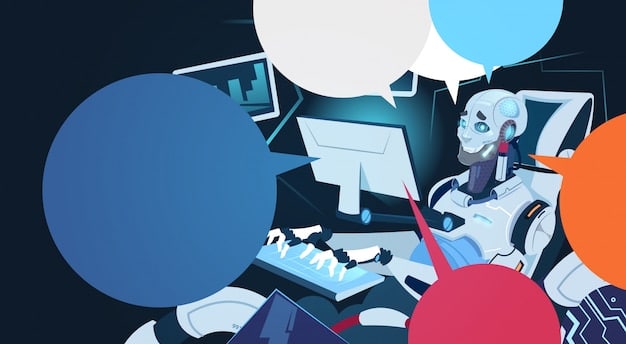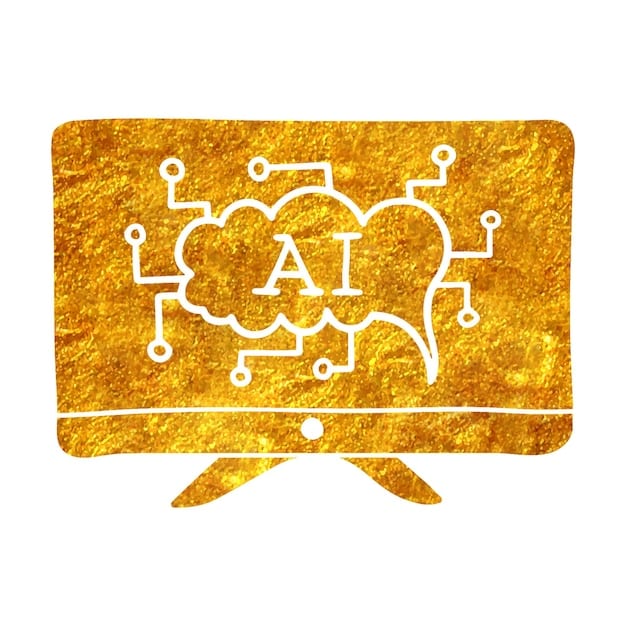AI Chatbots in US Customer Service: 2025 Transformation

By 2025, AI-powered chatbots are projected to revolutionize customer service in the US, offering personalized support, streamlining processes, and enhancing efficiency through machine learning and natural language processing.
The landscape of customer service in the United States is on the cusp of a significant transformation. By 2025, AI-powered chatbots are poised to become a ubiquitous presence, fundamentally altering how businesses interact with their customers and provide support.
The Rise of AI Chatbots in Customer Service
Artificial intelligence has been steadily making its way into various sectors, and customer service is no exception. The advancements in natural language processing (NLP) and machine learning (ML) have enabled the development of sophisticated AI chatbots capable of understanding and responding to customer queries with remarkable accuracy and efficiency. These chatbots are not merely automated response systems; they are intelligent virtual assistants designed to enhance the overall customer experience.
The adoption of AI chatbots in customer service is driven by several factors, including the increasing demand for instant support, the need to reduce operational costs, and the desire to provide personalized experiences. As businesses strive to meet these demands, AI chatbots are emerging as a key solution for transforming customer service operations.
Benefits of AI Chatbots for Businesses
Implementing AI chatbots can bring numerous advantages for businesses:
- 24/7 Availability: AI chatbots can provide round-the-clock support, ensuring that customers receive assistance regardless of the time zone or business hours.
- Cost Reduction: By automating routine tasks and handling a large volume of inquiries, AI chatbots can significantly reduce labor costs associated with traditional customer service models.
- Personalized Experiences: AI chatbots can analyze customer data and interactions to provide personalized recommendations and support, enhancing customer satisfaction and loyalty.
- Scalability: AI chatbots can easily scale to handle peak demand periods, ensuring consistent service quality even during high traffic situations.
In conclusion, the rise of AI chatbots in customer service is not just a technological trend but a strategic imperative for businesses looking to stay competitive and deliver exceptional customer experiences. By understanding the benefits and implementing AI chatbots effectively, companies can transform their customer service operations and drive significant business value.

How AI Chatbots Enhance Customer Experience
Customer experience (CX) is a critical differentiator in today’s competitive market. AI chatbots are playing an increasingly important role in enhancing CX by providing instant, personalized, and efficient support.
By understanding customer needs and preferences, AI chatbots can deliver tailored experiences that drive customer satisfaction and loyalty. Here’s how AI chatbots are enhancing customer experience:
Instant Support and Reduced Wait Times
One of the key benefits of AI chatbots is their ability to provide instant support. Unlike traditional customer service channels, such as phone or email, AI chatbots can respond to customer queries in real-time. This reduces wait times and ensures that customers receive immediate assistance, leading to higher satisfaction levels.
Personalized Interactions and Recommendations
AI chatbots can analyze customer data, such as purchase history, browsing behavior, and previous interactions, to provide personalized recommendations and support. By understanding customer preferences, AI chatbots can offer tailored solutions and suggestions, enhancing the overall customer experience.
Seamless Integration with Other Channels
AI chatbots can be seamlessly integrated with other customer service channels, such as phone, email, and social media. This ensures a consistent and cohesive experience across all touchpoints. For example, if a customer starts a conversation with an AI chatbot and needs further assistance, the chatbot can seamlessly transfer the conversation to a human agent, providing a smooth and uninterrupted experience.
- Improved Customer Satisfaction: Real-time support and personalized interactions lead to higher customer satisfaction levels.
- Increased Customer Loyalty: Tailored experiences and efficient support can foster stronger customer relationships and loyalty.
- Enhanced Brand Image: Providing cutting-edge customer service solutions can enhance a company’s brand image and reputation.
In conclusion, AI chatbots are transforming the way businesses interact with their customers, providing instant, personalized, and seamless support. By focusing on enhancing customer experience, companies can leverage AI chatbots to drive customer satisfaction, loyalty, and overall business success.
Key Technologies Powering AI Chatbots
The capabilities of AI chatbots are underpinned by several key technologies, including natural language processing (NLP), machine learning (ML), and artificial intelligence (AI). These technologies enable chatbots to understand, interpret, and respond to customer queries in a human-like manner.
Understanding these technologies is crucial for appreciating the sophistication and potential of AI chatbots. Here’s a closer look at the key technologies powering AI chatbots:
Natural Language Processing (NLP)
NLP is a branch of AI that focuses on enabling computers to understand, interpret, and generate human language. In the context of AI chatbots, NLP is used to analyze customer queries, identify intent, and extract relevant information. This allows chatbots to understand the meaning behind customer requests and provide appropriate responses.
Machine Learning (ML)
ML is a type of AI that enables computers to learn from data without being explicitly programmed. In the context of AI chatbots, ML is used to train chatbots on vast amounts of text and conversation data. This allows chatbots to improve their understanding of language, refine their responses, and adapt to new situations.
Artificial Intelligence (AI)
AI provides the overall framework for developing intelligent systems that can perform tasks that typically require human intelligence. AI chatbots leverage AI algorithms and techniques to automate customer service processes, personalize interactions, and provide efficient support.
- NLP Algorithms: Used for understanding and interpreting customer queries.
- ML Models: Used for training chatbots and improving their performance over time.
- AI Frameworks: Used for developing and deploying intelligent customer service solutions.
In summary, AI chatbots are powered by a combination of NLP, ML, and AI technologies. These technologies enable chatbots to understand customer needs, provide personalized support, and automate customer service processes, transforming the way businesses interact with their customers.

Challenges and Considerations for AI Chatbot Implementation
While AI chatbots offer numerous benefits, implementing them effectively requires careful planning and consideration. Businesses must address several challenges and considerations to ensure successful AI chatbot implementation.
Understanding these challenges is crucial for mitigating potential risks and maximizing the value of AI chatbot investments. Here’s a look at some of the key challenges and considerations:
Data Privacy and Security
AI chatbots often handle sensitive customer data, making data privacy and security a top priority. Businesses must implement robust security measures to protect customer data from unauthorized access, use, or disclosure. This includes encrypting data, implementing access controls, and complying with data privacy regulations.
Accuracy and Reliability
The accuracy and reliability of AI chatbots are critical for providing effective customer service. Businesses must ensure that their chatbots are well-trained, regularly updated, and capable of handling a wide range of queries. This requires continuous monitoring, testing, and refinement of chatbot algorithms.
Integration with Existing Systems
AI chatbots must be seamlessly integrated with existing customer service systems, such as CRM, help desk, and ticketing systems. This ensures a cohesive and consistent experience across all touchpoints. Integration can be complex and require careful planning to avoid disruptions to existing workflows.
- Training and Development: Investing in training and development programs to ensure that AI chatbots are well-trained and capable of handling a wide range of queries.
- Maintenance and Updates: Regularly maintaining and updating AI chatbots to improve their performance and address any issues.
- User Experience: Designing chatbots with a focus on user experience to ensure that they are easy to use and provide effective support.
In conclusion, implementing AI chatbots requires careful planning and consideration of various challenges and considerations. By addressing these challenges and prioritizing data privacy, accuracy, and integration, businesses can successfully implement AI chatbots and reap the benefits of enhanced customer service.
Impact on the Customer Service Workforce
The rise of AI chatbots is expected to have a significant impact on the customer service workforce in the US. While some fear that AI chatbots will replace human agents, the reality is more nuanced. AI chatbots are likely to complement human agents, augmenting their capabilities and freeing them up to focus on more complex and strategic tasks.
Understanding the impact of AI chatbots on the workforce is essential for managing the transition and ensuring that human agents are equipped with the skills and knowledge they need to thrive in the age of AI. Here are some of the key impacts:
Automation of Routine Tasks
AI chatbots can automate routine tasks, such as answering frequently asked questions, processing simple transactions, and providing basic support. This frees up human agents to focus on more complex and challenging tasks that require human empathy, critical thinking, and problem-solving skills.
Enhanced Agent Productivity
By handling routine tasks, AI chatbots can enhance agent productivity. Human agents can focus on resolving complex issues, building relationships with customers, and driving strategic initiatives. This leads to higher job satisfaction and improved customer outcomes.
New Job Roles and Opportunities
The implementation of AI chatbots will create new job roles and opportunities in areas such as chatbot development, training, and maintenance. Human agents can transition into these roles by acquiring new skills and knowledge, ensuring that they remain relevant and valuable in the workforce.
- Upskilling and Reskilling: Investing in upskilling and reskilling programs to equip human agents with the skills they need to work alongside AI chatbots.
- Collaboration: Fostering collaboration between human agents and AI chatbots to leverage their respective strengths.
- Focus on Human Skills: Emphasizing the importance of human skills, such as empathy, communication, and problem-solving, in customer service roles.
In summary, the rise of AI chatbots will transform the customer service workforce, creating new opportunities and challenges. By embracing AI and investing in upskilling and reskilling programs, businesses can ensure that their workforce is well-prepared for the future of customer service.
Future Trends in AI Chatbot Technology
The field of AI chatbot technology is rapidly evolving, with new innovations and advancements emerging on a regular basis. By 2025, we can expect to see even more sophisticated and capable AI chatbots that are transforming the way businesses interact with their customers.
Understanding future trends in AI chatbot technology is crucial for staying ahead of the curve and leveraging the latest innovations to enhance customer service operations. Here are some of the key trends to watch:
Improved Natural Language Understanding
Advancements in NLP will enable AI chatbots to understand and interpret human language with even greater accuracy and nuance. This will allow chatbots to handle more complex and ambiguous queries, providing more effective support.
Enhanced Personalization
AI chatbots will become even more personalized, leveraging data and analytics to understand individual customer preferences and tailor interactions accordingly. This will lead to more engaging and satisfying customer experiences.
Integration with Emerging Technologies
AI chatbots will be integrated with emerging technologies, such as virtual reality (VR) and augmented reality (AR), to provide immersive and interactive customer experiences. This will open up new possibilities for customer engagement and support.
- AI-Powered Analytics: Leveraging AI-powered analytics to gain deeper insights into customer behavior and preferences.
- Proactive Customer Service: Using AI chatbots to proactively identify and address customer issues before they escalate.
- Emotional Intelligence: Developing AI chatbots with emotional intelligence to better understand and respond to customer emotions.
In conclusion, the future of AI chatbot technology is bright, with new innovations and advancements on the horizon. By staying informed about these trends and leveraging the latest technologies, businesses can transform their customer service operations and deliver exceptional customer experiences.
| Key Aspect | Brief Description |
|---|---|
| ⏰ 24/7 Availability | AI chatbots provide round-the-clock support for immediate customer assistance. |
| 💰 Cost Reduction | Chatbots automate tasks, reducing labor costs in customer service operations. |
| 💡 Personalization | AI analyzes data for personalized customer experiences and recommendations. |
| ⚙️ System Integration | Chatbots are integrated with existing systems for cohesive service across channels. |
FAQ
▼
AI chatbots will deliver 24/7 support, reduce wait times, and offer personalized experiences by analyzing customer data. They’ll also streamline routine tasks, freeing human agents for more complex issues.
▼
AI chatbots are powered by Natural Language Processing (NLP), which enables them to understand human language; Machine Learning (ML), which allows them to learn from data; and Artificial Intelligence (AI) to automate processes.
▼
Key challenges include ensuring data privacy and security, achieving accuracy and reliability in responses, and seamlessly integrating chatbots with existing customer service systems and workflows.
▼
AI chatbots will automate routine tasks, enhancing agent productivity. This leads to human agents focusing on complex issues, fostering new roles in chatbot development and maintenance, emphasizing uniquely human skills in customer interactions.
▼
Future trends include enhanced Natural Language Understanding (NLU), more personalized customer experiences, and seamless integration with emerging technologies like VR and AR for immersive interactions, enhancing customer engagement.
Conclusion
In conclusion, AI-powered chatbots are set to significantly transform customer service in the US by 2025. By embracing these technologies and addressing the associated challenges, businesses can enhance customer experiences, improve operational efficiency, and stay competitive in the rapidly evolving landscape.





